Posts Tagged: lemon
Colorful and Tasty Neighborhood Bounty
I stroll pretty frequently through our neighborhood with dogs in tow. Many of my neighbors are gifted gardeners and I get a chance to check out and share in their summer bounty. While some of the "suburban farm plots" are shutting down for the season, others are still pumping out the tomatoes and squash. 'Bearss' Lime and 'Improved Meyer' lemon trees are bearing next to a driveway, volunteer squash are flowering by a hose spigot, baby lettuce is keeping company with Kranz aloe and bags of tasty tomatoes and squash appear at my front door along with peppers. Even okra grown from seeds brought in from Northern India is growing very well in the August sun.
Besides all this, one of my neighbors just brought over a dozen fresh eggs naturally colored in shades worthy of an Easter Egg Hunt. This hard working gardener has lots of that great by-product of chicken life she uses throughout her own salad bowl garden and orchard of fruit trees. And she lets a local beekeeper use a back corner for hives which produce lovely honey they both share.
Lots to see here when I put on my walking shoes and start looking around. It's a great way to stay in touch with my neighbors and share in their success as gardeners both literally and visually.
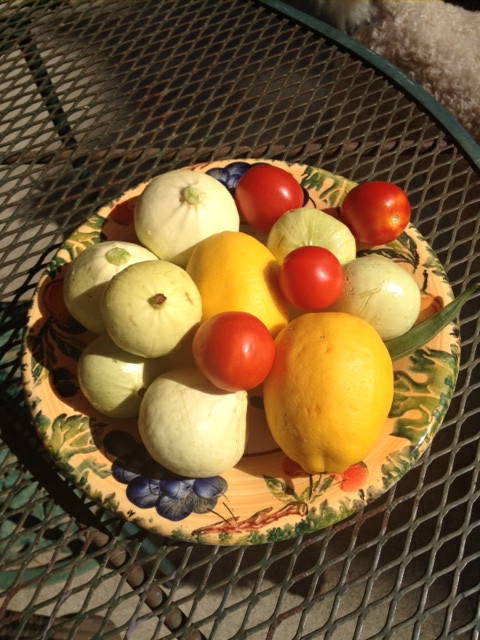
Shared bounty from neighbors. (photos by Trisha Rose)
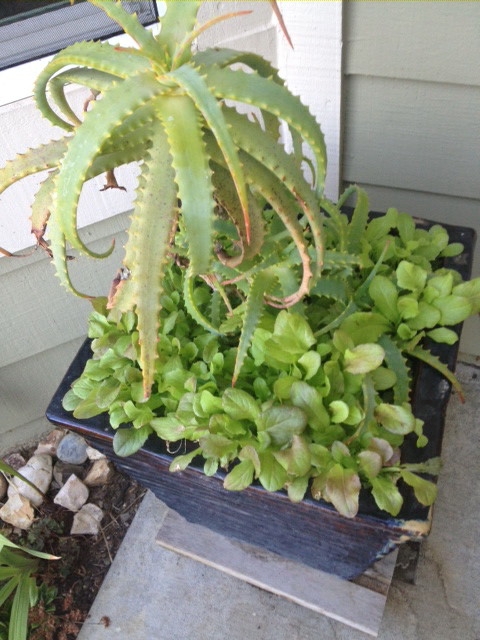
Aloe happliy growing with lettuce.
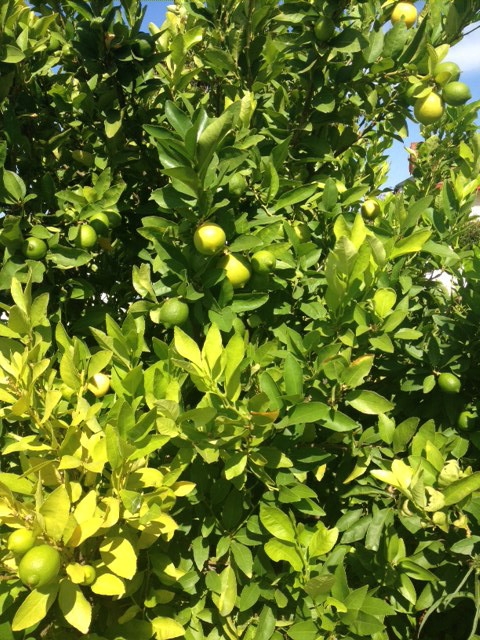
'Bearss' lime.
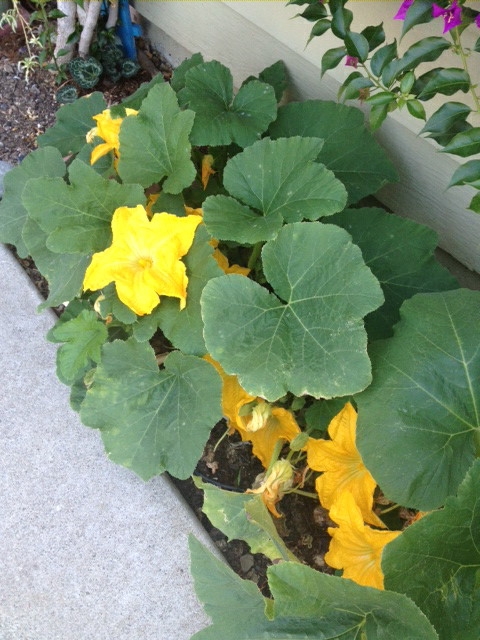
Volunteer squash in flower.
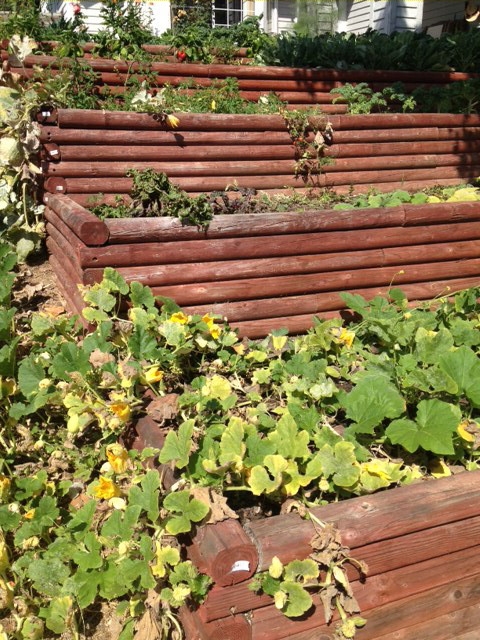
Planting beds, end of the season.
Lemony Goodness
My lemon verbena (Aloysia triphylla) shrub is planted near a window and has a very strong lemon scent when you brush by it or when the wind blows (here in Fairfield, which is most of the time.) If the window is open the lemon scent comes into the room.
The shrub is pruned to about 6 feet , I try to keep it to 5-6 feet tall and about 2 feet wide, if I did not keep it at the height it would grow to about 8 feet. In lemon verbena’s native country of South America, it can grow to 15 feet tall. If you let them get too tall and wide they tend to get very messy looking. This shrub is planted where it gets only the late afternoon sun, but the Sunset Western Garden Book says they need full sun.
They do like a lot of water and good drainage to keep them looking their best. I have not seen any pest on my shrub, but they can be bothered by whitefly and spider mites. Spraying with an insecticidal soap will help with that problem.
In the spring and early summer, it has small white flowers on the end of the branches. Even after the flowers fade the left-over flower inflorescences are interesting to look at. This shrub goes dormant in the winter, and that is when it gets it heavy pruning. I take it down to about 2 feet above the ground, knowing it will come back stronger the next year, so far this 8 year old shrub has not failed that test.
I bring some of the branches, with the flowers, into the house put them in a vase with other flowers if I have them. If not, I just use the lemon verbena stems in the vase helps to release the lemon fragrance into the room. They will last about a week this way.
This is a very easy plant to propagate. Doing it in summer with a soft wood cutting and putting into potting soil, should bring new starts in about 2 months.
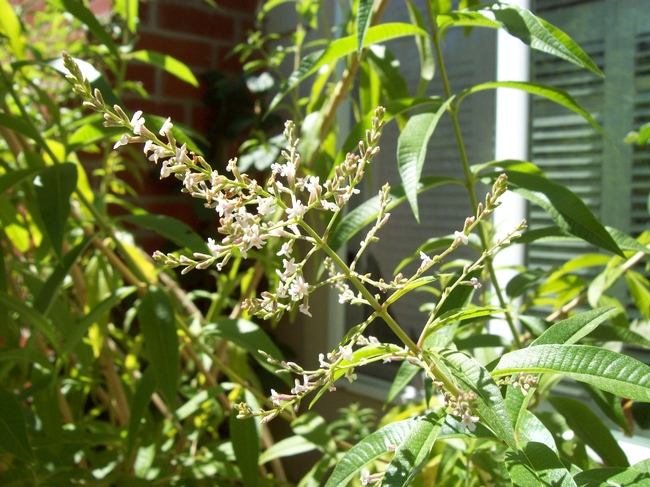
Lemon verbena flowers. (photos by Betty Victor)
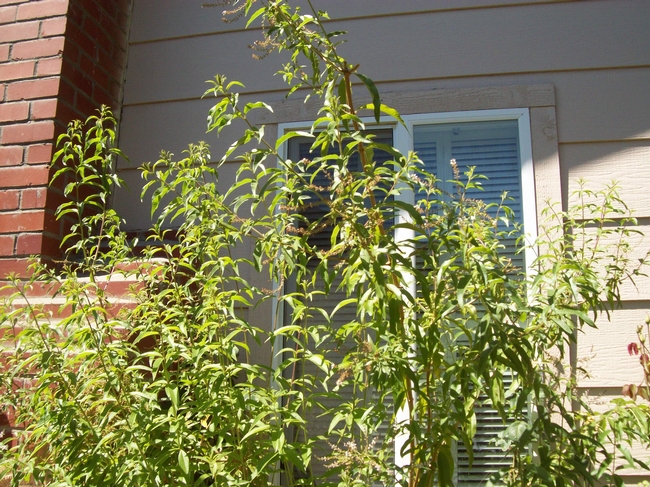
Lemon verbena plant.
Lemon Tree
Sometime ago, I wrote about my sad lemon tree that had blossoms and no leaves. Well now it has one green stem with 2 leaves and a small lemon, yes a lemon!
If you remember this is the tree that I consulted a citrus grower, looked on the IPM web site, and contacted Lance Walhem, who wrote a book on citrus, and they were stumped as to what was going on with it and so they could not give me any information on what I could do.
So I decided to let it be and only water it, when I watered my other citrus. I did not even give it any fertilizer as I was sure it would not survive, and it is still a very sad looking tree. I am not sure it is going to survive, but maybe the tree has made the decision to try and survive.
I will be surprised if the lemon it has stays and continues to grow to maturity, but for now it has a lemon.
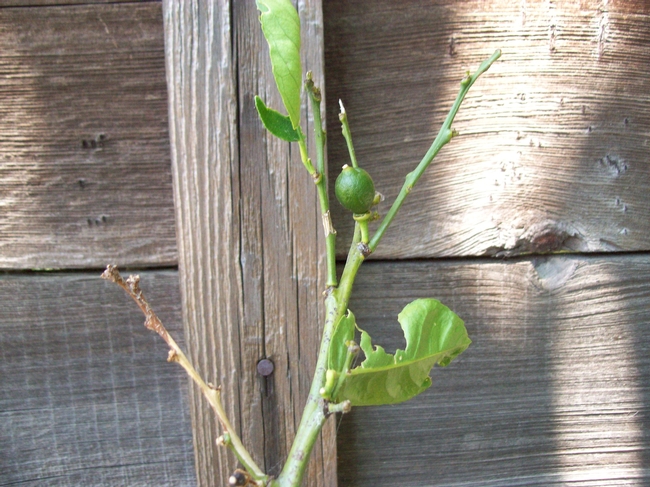
The lemon on the sad tree. (photo by Betty Victor)
The Story of a Sad Lemon Tree
Sometimes gardening problems really stump me as this one has now, so maybe someone who reads this will be able to help.
I have a lemon tree that some of you might have heard me talk about, if not this is the story.
I was given this ‘Meyer’ lemon about 4 years ago. It had bright, healthy green leaves and over all, the plant looked good. I planted it just like I have planted my other citrus. However, about 7 months later I noticed it was losing its leaves. Not knowing what was going on, I looked in our California Master Gardener Handbook for an answer, and I also went on the IPM website (http://ipm.ucdavis.edu) for information on what the problem might be. I found no answers there either, so I contacted Lance Walheim who had written a book on citrus called Citrus: Complete Guide to Selecting & Growing More Than 100 Varieties. I figured he knows citrus and their problems, but it turns out that he was as baffled as I was and didn’t have an answer for me either.
During this time the tree had blossoms, but no leaves! The next year it had leaves on one side, no blossoms on the other side. Then the leaves fell off and blossoms on one side appeared.
This year again blossoms, no leaves. After exhausting all the places and people for ideas and being baffled I have decided to let the leafless, blossom bearing lemon do its own thing. I don’t know how long it will go on like this as it goes into its 5th year of life. Oh by the way it has never had fruit.
Citrus
One of the things I love about living in Solano County is that we can successfully grow all kinds of citrus trees. I've got quite a few in my backyard - a Meyer lemon tree (Citrus x meyeri), a Robertson orange (Citrus sinensis 'Robertson'), a Bearss lime (Citrus latifolia), and unknown varieties of a blood orange tree (Citrus sinensis) and a kumquat tree (Fortunella spp). They have all been planted over the last 10 years, and slowly, they've grown quite tall (save for the kumquat!). Production has slowly increased, too. In the case of the lemon and orange trees, maybe a bit too good.
Am I the only one who has this little dilemma? The orange tree produces so many oranges, and there are only so many oranges my family is willing to eat. The blood orange tree had four fruits last year. This year, about fifty. I'm a bit nervous to see what happens next year.
The one that amazes me is the Meyer. Our lemon tree has been pruned, hacked, topped, and chopped, yet it still produces what I would certainly call "tons" of lemons. What do I do with all of them? I've made lemon meringue pie (2 lemons), a pitcher of homemade lemonade (10 lemons), hot tea with lemon for a sore throat (1 lemon), bags of lemons for the neighbors (maybe 50 or 60 lemons). Yet still, my tree is heavily drooping with lemons.
Don't misunderstand, I'm glad to have such a bountiful harvest of citrus fruits every winter. There's nothing to brighten up a gray winter January day than to look out and see the orange and yellow fruits hanging sweetly on the trees. Unfortunately, they won't last out there forever, so we need to be creative and find ways to enjoy them without having to partake of them. I recently learned a great new decorating technique - fill a large glass vase with citrus fruits, and enjoy the sweet smell of lemons and oranges in your home as they slowly dry.
So…until I learn of another way to make use of my citrus fruits, my home will be filled with all sizes of glass vessels full of lemons and oranges.

